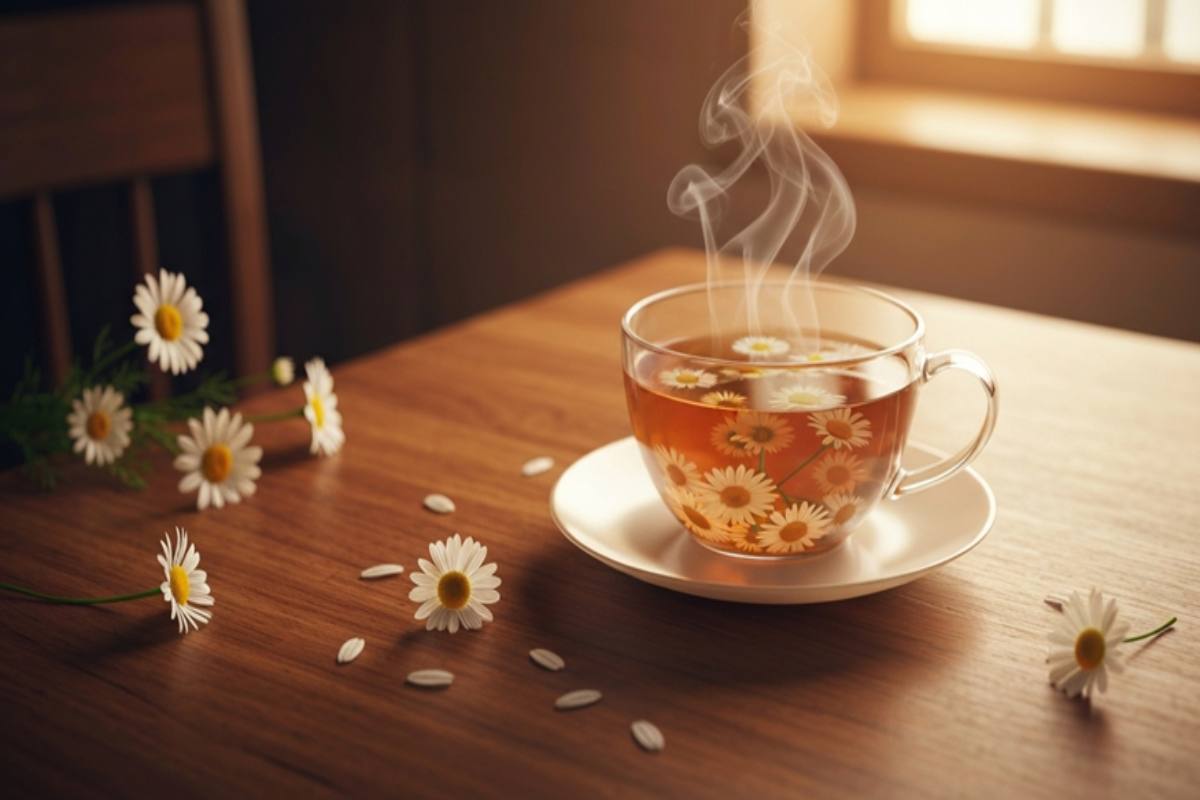Key Highlights
How to Make Chamomile Tea – Making your own chamomile tea is a simple and rewarding process you can easily do at home.
- This popular herbal tea can be brewed using either fresh flowers or dried chamomile blossoms.
- Our easy-to-follow chamomile tea recipe guide helps you create the perfect soothing beverage.
- You only need chamomile blossoms and hot water to get started on this calming drink.
- For the best flavor, steep the flowers for about five minutes before enjoying your tea.
- You can grow your own chamomile, ensuring a fresh supply for your tea whenever you want.
Introduction
Welcome to the world of homemade chamomile tea! This beloved beverage is famous for its calming qualities and is a favorite for winding down. For centuries, people have enjoyed a warm cup of chamomile tea to relax and soothe their senses. The great news is that you don’t need to be an expert to brew it. With fresh or dried flowers from chamomile plants, you can easily create this delightful tea right in your kitchen. This guide will walk you through every step.
Understanding Chamomile Tea
Chamomile tea is a type of herbal tea, also known as a tisane. This means it’s made by infusing chamomile flowers in hot water and doesn’t contain any leaves from the actual tea plant. It’s naturally caffeine-free, making it a wonderful choice for any time of day. The flavor is light and sweet with crisp, apple-like notes.
There are two main types used for herb teas: German chamomile and Roman chamomile. You can brew your tea using either fresh or dried flowers, and each offers a slightly different taste experience. Tea made from fresh flowers often has a sweeter, less bitter flavor than tea made from dried flowers or tea bags.
What Is Chamomile and Where Does It Come From?
So, what exactly is chamomile? It’s a plant known for its small, daisy-like flowers with white petals and bright yellow centers. For centuries, chamomile has been valued for its medicinal properties and is a staple in natural remedies for relaxation and digestion. The tea itself is brewed using only the flower heads of the plant.
The two most common varieties for making chamomile tea are German chamomile and Roman chamomile. While they have slight differences, both are hardy plants that grow across the world. Originally native to Europe and Asia, these plants are now commonly found in the Americas as well.
You can even grow these plants in your own garden without much difficulty. Later on, we will share a simple step-by-step recipe for making chamomile tea at home, so you can transform your own chamomile flowers into a soothing drink.
Differences Between Fresh and Dried Chamomile Flowers
When preparing your chamomile tea, you have the choice between using fresh flowers or dried ones. Does it make a difference? Yes, it certainly does. Using fresh flowers often results in a superior flavor that is sweeter and has fewer bitter undertones. It creates a light, airy cup of tea with a fresh, slightly sweet aroma.
On the other hand, tea made from the dried flowers of the chamomile plant, including what you find in most tea bags, can sometimes have a stronger, slightly more bitter taste. The choice really comes down to your personal preference and what you have available.
Both options will give you a wonderful cup of tea. Here is a quick comparison to help you decide.
| Feature | Fresh Chamomile Flowers | Dried Chamomile Flowers |
| Flavor | Sweet, light, with notes of crisp apple and fewer bitter undertones. | Can be slightly more bitter, with a more concentrated flavor. |
| Aroma | Fresh, floral, and subtly sweet. | More earthy and herbaceous. |
| Availability | Found in home gardens, at farmer’s markets, or specialty stores. | Widely available in stores, online, and in tea bags. |
Essential Equipment and Ingredients for Making Chamomile Tea
Before you start brewing, let’s gather what you’ll need. The good news is that making this herbal tea doesn’t require much. The main ingredient is, of course, chamomile flowers. You can find them fresh at farmer’s markets or grow them yourself. Dried flowers are also readily available at most health food stores.
Besides the flowers, you will need a tea kettle to heat your water and a way to strain the blossoms. Preparing fresh flower teas is a delightful experience, and having the right tools makes it even better. Below, we’ll cover how to choose your flowers and what equipment will help you brew the perfect cup.
Choosing Between Fresh and Dried Chamomile Flowers
Deciding between fresh and dried chamomile is your first step. Many tea lovers prefer using fresh flowers because they offer a superior flavor and the fresh scent of chamomile tea is simply unmatched. If you have a garden, growing your own is a fantastic way to have a ready supply.
If you don’t have access to fresh flowers, don’t worry. Tea made from the dried flowers of the chamomile plant is also delicious and very convenient. You can find high-quality dried blossoms at health food stores or online. They have a longer shelf life and are easy to store.
Here are a few points to consider:
- Fresh flowers: Provide a sweeter, more delicate flavor and a wonderful aroma. They are perfect if you can grow them or find them locally.
- Dried flowers: Offer convenience and are widely available. They have a more concentrated flavor and are a great option for stocking your pantry.
- Tea bags: The most convenient option, but the flavor might not be as nuanced as loose-leaf dried or fresh flowers.
Recommended Tools for Brewing the Perfect Cup
To brew a perfect cup of chamomile tea, having a few basic tools can make all the difference. You don’t need anything fancy, but the right equipment ensures you get the best flavor from your flowers. The most important tool is a good tea kettle for boiling your water.
Once the flowers have steeped, you’ll need to separate them from the water. An infusion tea kettle often has a built-in strainer, which is ideal for fresh flowers. If you don’t have one, a simple tea ball or a fine mesh strainer will work perfectly. You can even use a piece of cheesecloth as a makeshift tea bag. For latte variations, a milk frother comes in handy.
Here are the key tools:
- Tea Kettle: To boil water. An infusion kettle is a great choice for loose flowers.
- Strainer: A fine mesh sieve, tea ball, or cheesecloth to separate the flowers from the tea.
- Mug: Your favorite cup to enjoy the final product.
Step-by-Step Guide to Making Chamomile Tea at Home
Are you ready to make your own homemade chamomile tea? The process is incredibly simple and rewarding. Following a basic chamomile tea recipe will help you achieve a perfect, soothing brew every time. Whether you use fresh or dried flowers, the fundamental steps are the same: prepare your flowers, steep them in hot water, and strain.
This guide is like a virtual recipe card that will show you exactly how to prepare a delicious cup of chamomile tea. From harvesting the flowers to adding your favorite flavors, we’ll cover everything you need to know. Let’s get started on your journey to the perfect homemade tea.
Step 1: Harvesting or Selecting Chamomile Flowers
The first step in making fresh chamomile tea is getting your hands on the flowers. If you’re growing chamomile plants in your home garden, harvesting is easy. You’ll want to pick the chamomile blossoms when they are fully open. Simply remove the entire flower heads of the plant from the stems.
Once harvested, give the flowers a gentle rinse in warm water and pat them dry. It’s best to use your fresh herbs right away for the best flavor. However, if you need to store them, you can wrap the rinsed petals in a damp paper towel and place them in an airtight container in the refrigerator for up to 48 hours.
Here’s a quick summary of how to prepare your flowers:
- Harvest: Pick the flower heads when they are fully bloomed.
- Rinse: Gently wash the flowers in warm water to remove any dirt.
- Dry: Pat them dry before steeping to avoid diluting your tea.
Step 2: Preparing Water and Steeping Chamomile
Now that your flowers are ready, it’s time to prepare the water. For the best-tasting tea, always use pure or spring water rather than tap water, as it preserves the delicate flavors of the chamomile. You’ll want to heat water in a tea kettle or a pot on the stove until it reaches a boil.
Once you boil water, let it cool for just a minute before pouring it over your chamomile flowers. This slightly cooler hot water prevents the delicate petals from getting scorched. Place your flowers in an infuser, tea ball, or directly into your pot, and let them steep for about 5 minutes. This steeping time is perfect for extracting the flavor without any bitterness. If you are using tea bags, follow the same time recommendation.
Key points for steeping:
- Water Quality: Use pure or spring water for the cleanest taste.
- Water Temperature: Boil water, then let it cool for a minute before pouring.
- Steeping Time: Let the chamomile steep for 5 minutes for optimal flavor.
Step 3: Flavor Enhancements and Delicious Variations
A simple cup of chamomile tea is wonderful on its own, but you can also customize it with different flavors. A splash of lemon juice can add a bright, zesty note, while a touch of honey or maple syrup can provide natural sweetness. For a refreshing twist, try adding a few fresh mint leaves to your brew.
Feeling more adventurous? You can create all sorts of delicious variations. A chamomile tea latte is a creamy and comforting option made by adding frothed milk. On a hot day, a cool glass of iced chamomile tea with ginger and lemon is incredibly refreshing. You can even create a chamomile hot toddy for a warming winter beverage.
Here are a few ideas to get you started:
- Simple Add-ins: Honey, lemon juice, maple syrup, or mint leaves.
- Creative Recipes: Try making a chamomile tea latte or a pitcher of iced chamomile tea.
- Winter Warmer: A chamomile hot toddy with whiskey or bourbon is perfect for cold nights.
Conclusion
In summary, making chamomile tea can be a delightful and soothing experience. Whether you choose fresh or dried flowers, the process of selecting, steeping, and enhancing your tea opens up a world of flavor and relaxation. Embracing the art of brewing chamomile not only allows you to enjoy its calming properties but also empowers you to personalize each cup to your taste. As you embark on this journey, remember that every step—from harvesting the flowers to adding your favorite flavor enhancements—contributes to a unique tea experience. Ready to enjoy a comforting cup of chamomile tea? Get started today and savor the tranquility it brings!
Frequently Asked Questions
How does tea made from fresh flowers compare to dried chamomile?
Tea made with fresh flowers generally has a lighter, more delicate flavor profile. It offers a sweeter taste with fewer bitter notes compared to dried chamomile. This results in a bright, airy cup of tea with a fresh floral aroma, making your chamomile tea experience wonderfully fragrant and smooth.
What is the ideal steeping time and water temperature for chamomile tea?
For perfect chamomile tea, bring fresh, pure water to a boil and then let it cool for about a minute. Pour this hot water over your flowers. The ideal steeping time is five minutes. This allows the flavors to fully develop without releasing any bitterness into your warm water infusion.
Are there creative recipes or add-ins to customize chamomile tea?
Yes, absolutely! You can easily customize your tea with a touch of honey, a squeeze of lemon juice, or a drizzle of maple syrup for sweetness. For a different twist, add fresh mint leaves for a refreshing taste or make a creamy chamomile tea latte with frothed milk.
Can I grow chamomile at home and use it for tea?
Yes, you can easily grow chamomile plants in a home garden. They are hardy and don’t require much fuss. Harvesting your own chamomile blossoms allows you to use the freshest herbs for your tea, ensuring superior flavor. Simply pick the flower petals and brew them for a truly homemade experience.
Also read: How to Get Rid of Mucus in Throat: Effective Remedies


